
Home


Hungary


Cardinal József Mindszenty


1956 Hungarian Revolution (My Story)
(My Eyewitness story of our Freedomfight
and Resistance against the Soviet Invasion)


50th Anniversary of our Freedomfight


My Travel Pages

Africa

America

Asia

Europe

Hungary

Oceania
My Russia pages

Russia
Russia History & Facts in brief
Moscow

Moscow

Catholic Cathedral

Christ the Saviour Cathedral

Kazan Cathedral

Kremlin

Kremlin Cathedrals

Moscow Airport

Moscow Buses

Moscow Metros

Novodevichy Convent

Red Square

Virgin on the Moat Cathedral
- - -
- -
Saint Petersburg

Saint Petersburg

Artillery Museum

Hermitage

Kronstadt

Peterhof

Oranienbaum

Peter and Paul Fortress

Saint Petersburg Airport

Saint Petersburg Buses

Saint Petersburg Metros

Saint Petersburg Trams

Vyborg
- - -
- -
Vladivostok

Vladivostok

Vladivostok Buses

Vladivostok Trains

Vladivostok Trams
- - -
- -
Volgograd

Volgograd

Tractor Factory - Museum

Volgograd Airport

Volgograd Buses

Volgograd Trams

Volgograd Trolleybuses
|

Russia facts & history in brief
 My Russia pages directory
My Russia pages directory
Map of Russia
Christ the Saviour Cathedral
Excerpted from Wikipedia, the free encyclopedia
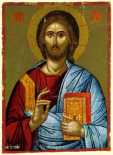
Christ the Saviour
The Cathedral of Christ the Saviour
is the tallest Eastern Orthodox
Church in the world.
It is situated in Moscow, on the bank of the
Moskva River, a few blocks west of the Kremlin.
Design
When the last of Napoleon's soldiers left Moscow, Tsar
Alexander I signed a manifesto, December 25, 1812,
declaring his intention to build a Cathedral in honor
of Christ the Saviour "to signify Our gratitude to
Divine Providence for saving Russia from the doom
that overshadowed Her" and as a memorial to the
sacrifices of the Russian people.
It took some time for actual work on the projected
cathedral to get started.
The first finished architectural project was
endorsed by Alexander I in 1817.
It was a flamboyant Neoclassical design full of
Freemasonic symbolism.
Construction work was begun on the Sparrow Hills,
the highest point in Moscow,
but the site proved insecure.
In the meantime Alexander I was succeeded by
his brother Nicholas.
Profoundly Orthodox and patriotic, the new Tsar
disliked the Neoclassicism and Freemasonry of the
project selected by his brother.
He commissioned his favourite architect Konstantin
Thon to create a new design, taking as his
model Hagia Sophia in Constantinople.
Thon's Neo-Byzantine design was approved in 1832,
and a new site, closer to the Moscow Kremlin,
was chosen by the Tsar in 1837.
A convent and church on the site had to be relocated,
so that the cornerstone was not laid until 1839.
Construction
The Cathedral had taken many years to build and did not
emerge from its scaffolding until 1860.
Some of the best Russian painters (Ivan Kramskoi, Vasily
Surikov, Vasily Vereshchagin) continued to embellish
the interior for another twenty years.
The Cathedral was consecrated on the very day Alexander
III was crowned, May 26, 1883.
A year earlier, Tchaikovsky's 1812
Overture debuted there.
The inner sanctum of the church (naos) was ringed by a
two-floor gallery, its walls inlaid with rare sorts of
marble, granite, and other precious stones.
The ground floor of the gallery was a memorial dedicated
to the Russian victory over Napoleon.
The walls displayed more than 1,000 square meters of Carrara
bianca marble plaques listing major commanders, regiments,
and battles of the Patriotic War of 1812 (with the lists
of awards and casualties appended).
The second floor of the gallery was
occupied by church choirs.
Demolition
After the Revolution and, more specifically, the death of
Lenin, the prominent site of the cathedral was chosen by
the Soviets as the site for a monument to socialism
known as the Palace of Soviets.
This monument was to rise in modernistic, buttressed
tiers to support a gigantic statue of Lenin perched
atop a dome with his arm raised in blessing.
On December 5, 1931, by order of Stalin's minister
Kaganovich, the Cathedral of Christ the Saviour was
dynamited and reduced to rubble.
It took more than one blast to destroy the church and
more than a year to clear the debris from the site.
The original marble high reliefs were preserved and
are now on display at the Donskoy Monastery.
For a long time, they were the only reminder
of the largest Orthodox church ever built.
The construction of the Palace of Soviets was
interrupted due to a lack of funds, problems
with flooding from the nearby Moskva River,
and the outbreak of war.
The flooded foundation hole remained on the
site until, under Nikita Khrushchev, it was
transformed into a huge public swimming pool,
the largest the world has ever seen.
New cathedral
With the end of the Soviet rule, the Russian Orthodox
Church received permission to rebuild the Cathedral
of Christ the Saviour in February 1990.
A temporary cornerstone was laid by the end of the year.
The restorer Aleksey Denisov was called upon
to design a replica of extraordinary accuracy.
A construction fund was initiated in 1992 and funds
began to pour in from ordinary
citizens in the autumn of 1994.
When construction was well under way, Denisov was
replaced by Zurab Tsereteli who introduced
several controversial innovations.
For instance, the original marble high reliefs
along the walls gave way to the modern bronze ones,
which have few if any parallels in
Russian church architecture.
The lower church was consecrated to the Saviour's
Transfiguration in 1996, and the completed
Cathedral of Christ the Saviour was consecrated
on the Transfiguration day, August 19, 2000.
A pedestrian bridge across the river from
Balchug was constructed between 21 June 2003
and 3 September 2004 (details, photo).
On the slope of the hill to the right from
the cathedral are the monumental statues
of Alexander II and Nicholas II.
The cathedral square is graced by several
chapels, designed in the same
style as the cathedral itself.
Below the new church is a large hall for church
assemblies, where the last Russian Tsar, and his
family were glorified as saints in 2000.
On May 17, 2007, the Act of Canonical Communion
between the Moscow Patriarchate of the Russian
Orthodox Church and the Russian Orthodox Church
Outside Russia was signed there.
The full restoration of communion with the Moscow
Patriarchate was celebrated by a Divine Liturgy
at which the Patriarch of Moscow and All Russia,
Alexius II and the First Hierarch of ROCOR,
Metropolitan Laurus, concelebrated the Divine
Liturgy for the first time in history.
The first Russian President Boris Yeltsin, who
died of heart failure on April 23, 2007, lay
in state in the cathedral prior to his
funeral on Novodevichy Cemetery.

For a more information about
Christ the Saviour Cathedral see Wikipedia, the free encyclopedia

This page was retrieved and condensed from
(http://en.wikipedia.org/wiki/Christ_the_Saviour_Cathedral)
see Wikipedia, the free encyclopedia, January 2008.
All text is available under the terms of the
GNU Free Documentation License
(see
Copyrights for details).
About Wikipedia
Disclaimers

This information was correct in January 2008. E. & O.E.

2007
You can click on these photos for an enlargement
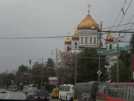 |
 |
| Christ the Saviour Cathedral |
Christ the Saviour Cathedral |
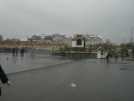 |
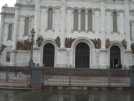 |
| Christ the Saviour Cathedral |
Christ the Saviour Cathedral |
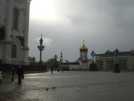 |
 |
| Christ the Saviour Cathedral |
Christ the Saviour Cathedral |
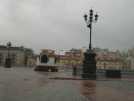 |
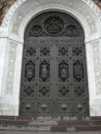 |
| Christ the Saviour Cathedral |
Christ the Saviour Cathedral |
 |
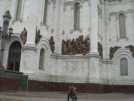 |
| Christ the Saviour Cathedral |
Christ the Saviour Cathedral |
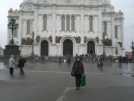 |
 |
| Christ the Saviour Cathedral |
Christ the Saviour Cathedral |

|